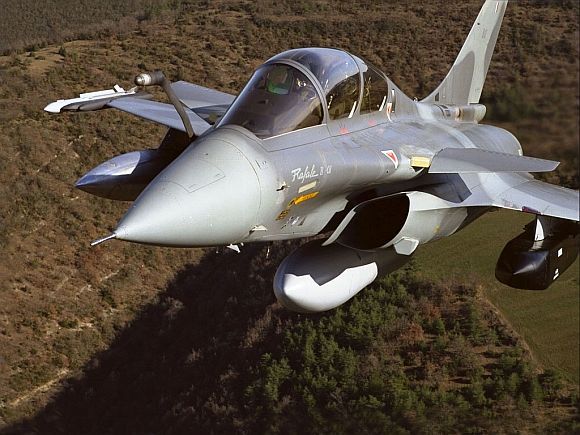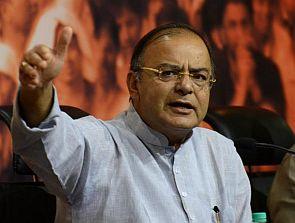 What the new defence minister does with the Rafale fighter jet deal will decide if India wants to build genuine, long-term defence capability through an indigenous product that slashes life-cycle costs, or opt for glitzy signing ceremonies with foreign vendors, says Ajai Shukla.
What the new defence minister does with the Rafale fighter jet deal will decide if India wants to build genuine, long-term defence capability through an indigenous product that slashes life-cycle costs, or opt for glitzy signing ceremonies with foreign vendors, says Ajai Shukla.
The one positive from having Arun Jaitley run the ministry of defence in addition to his time-consuming job as finance minister is that, like Pranab Mukherjee, he will be better equipped to evaluate defence expenditure proposals that come up to the finance ministry.
On the flip side, his current preoccupation with the finance ministry would leave him little time to scrutinise the fundamentals -- whether the military is manned, equipped and run effectively, why weaponry is imported, and what policies could promote indigenous defence production.
It would be tragic if Jaitley concludes that boosting overseas arms procurement is the way to strengthen the military. It can be safely assumed that, despite the tight fiscal situation, the Bharatiya Janata Party's optics will trigger a moderate rise in the capital budget. What remains to be seen is whether Jaitley directs most of that money to the international arms bazaar or to shoring up India's defence production capability.
An example of this is the defence ministry's key procurement dilemma: that is, whether to sign the controversial Rs 1-lakh-crore contract for 126 Dassault Rafale fighters for the Indian Air Force. The new government would relish the glitzy spectacle of a Rafale-signing ceremony. That would please the public and placate the IAF, but it would also require allocating Rs 15,000 crore as the signing advance; and commit the IAF to annual instalments of some Rs 10,000 crore, payable yearly till 2023-24.
Yet, a searching examination by Jaitley, below, left, would have discovered that a fraction of that expenditure -- spent on improving the serviceability rate of the Sukhoi-30 MKI -- could generate equivalent combat power. By 2019, the IAF will have 272 Sukhoi-30 MKIs; yet, poor maintenance and inefficient spares management ensure that just 40 per cent of these fighters are combat-ready at any given time.
Effectively, the IAF has just 109 combat-ready Sukhoi-30 MKIs; 272 is an illusory number. Raising serviceability to 75 per cent, which is up to par for any self-respecting air force, would add 95 fighters to the numbers operationally available. That is precisely the number of Rafales that would be operationally available from a 126-fighter fleet, given a 75 per cent serviceability rate.
 This mind-boggling truth needs reiteration, since the IAF and the defence ministry gloss over it -- spending Rs 5,000 crore to boost Sukhoi-30 MKI serviceability would "buy" as many additional fighters as the purchase of 126 Rafales for Rs 1 lakh crore. The IAF lament of "dwindling squadron numbers" is a red herring; more important is the number of fighters available in each squadron.
This mind-boggling truth needs reiteration, since the IAF and the defence ministry gloss over it -- spending Rs 5,000 crore to boost Sukhoi-30 MKI serviceability would "buy" as many additional fighters as the purchase of 126 Rafales for Rs 1 lakh crore. The IAF lament of "dwindling squadron numbers" is a red herring; more important is the number of fighters available in each squadron.
Further, abandoning the Rafale would save money for a light fighter fleet and also build an indigenous aerospace industry. The IAF's obsolescent MiG-21 and MiG-27 fleets could be replaced economically with an improved (or Mark II) version of the Tejas Light Combat Aircraft; its development and manufacture accelerated through a strategic alliance with Swedish company Saab, which is close to completing the Griper E -- a fighter very much like what the IAF wants the Tejas Mark II to be.
With the Defence Research and Development Organisation co-operating with Saab, a world-class Tejas Mark II would start joining the IAF fleet by 2019 (assuming five years for development and testing); and a second aircraft manufacturing line would be established in India, complete with an airfield, to complement the Hindustan Aeronautics' facilities at Bangalore.
Further, a project like this would catalyse an entire aeronautical design and manufacturing ecosystem, especially the small and medium firms that wither away when the government buys overseas rather than innovating and producing domestically.
Alongside this, aerospace engineering courses could be sponsored in selected technological institutes, which would feed into the indigenous design and manufacture of an advanced medium combat aircraft, a project already under way.
Finally, with the change left over from the Rs 1 lakh crore, New Delhi could press Stockholm hard to buy out Saab's aerospace division. The Swedish government might resist, but its decision would eventually be driven by how much it wants a strategic alliance with an emerging superpower like India.
The army faces similar dilemmas, with expensive overseas buys counterposed against indigenous alternatives -- whether to buy more Russian T-90 tanks or expedite the DRDO's Future Main Battle Tank project, which has languished for years; whether to buy more Russian armoured carriers or fast-track the Future Infantry Combat Vehicle, which India's defence industry is to develop.
For critically needed artillery guns, the dilemma is whether to approach the international arms bazaar or sponsor industry-led consortia to develop the guns in India, while confining overseas purchases to high-tech purchases, such as the ultralight howitzer, that require materials and engineering technologies currently out of our reach.
In each case, the defence ministry faces temptation to seal a quick overseas deal. At the same time, it also has the opportunity to build genuine, long-term defence capability through an indigenous product that slashes life-cycle costs to obtain "bang for the buck".
The policy framework for going swadeshi already exists. Ironically, it was created by the defence ministry under A K Antony, which then lacked the political courage to implement its own policies. The Defence Procurement Procedure of 2013 explicitly states that indigenous development and manufacture is the default option.
There is a Defence Production Policy to encourage manufacture. More policy initiatives are needed -- especially in reducing duties and tariffs for the domestic industry that, incredibly, pays higher taxes for building weaponry in India than foreign vendors pay for importing it fully built.
The domestic industry must be protected against variation in foreign exchange rates; export of defence equipment must be not just permitted, but actively encouraged; and foreign direct investment in defence must be automatically allowed up to 49 per cent.











